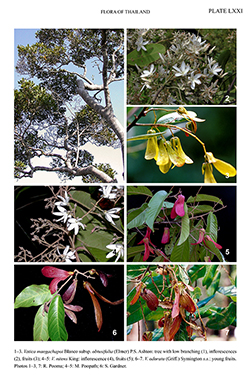e-Flora of Thailand
Volume 13 > Part 4 > Year 2017 > Page 678 > Dipterocarpaceae > Vatica
10. Vatica odorata (Griff.) Symingtonwfo-0000423198
J. Malayan Branch Roy. Asiat. Soc 19: 156. 1941; P.S.Ashton, Gard. Bull. Singapore 31: 23. 1978; Smitinand, Santisuk & Phengklai, Thai Forest Bull., Bot. 12: 84. 1980; P.S.Ashton, Fl. Males., Ser. 1, Spermat. 9: 360. 1982, excl. syn. V. fleuryana (= V. guangxiensis); Smitinand, J.E.Vidal & P.H.Hô, Fl. Cambodge, Laos & Vietnam 25: 52, t. 8, figs. 5–6. 1990; Pooma & M.F.Newman, Thai Forest Bull., Bot. 29: 181. 2001; Pooma, Thai Forest Bull., Bot. 30: 14. 2002; Symington, P.S.Ashton & S.Appanah, Malayan Forest Rec. 16: 469. 2004; Poopath, Sookchaloem & Santisuk, Thai Forest Bull., Bot. 40: 70. 2012; Gardner, Sidisunthorn & Chayamarit, Forest Trees S. Thailand Vol. 1: 474, fig. 705. 2015.— Sunaptea odorata Griff., Not. Pl. Asiat. 4: 516. 1854.— Anisoptera odorata (Griff.) Kurz, Flora 55: 190. 1872. Plate LXXI: 6–7.
Accepted Name : This is currently accepted.
Synonyms & Citations :
Description : Tree, 8–25 m tall; resin clear white to yellow-orange. Indumentum scurfy and sparsely to densely short reddish brown tufted tomentose on twigs, inflorescences and flower buds, somewhat persistent. Twigs sometimes lenticellate. Buds ellipsoid, 3–5 mm. Stipules lanceolate or ovate-oblong, thickened, ca 0.4–1 by 0.1–0.2 cm. Leaves elliptic, oblong, oblanceolate, occasionally irregular shape to obovate or ovate, 5.5–18 by 2–7 cm; base acute, obtuse to slightly cordate; apex acute to acuminate; secondary nerves 8–17 on each side, intermediate nerves present, arching at a distance from the margin, raised on both surfaces; midrib raised above; tertiary nerves reticulate to scalariform-reticulate, slightly prominent on both surfaces; petioles stout, 0.5–2 cm long. Inflorescences 2–8 cm long, irregularly branched; branchlets 0.5–2 cm long, bearing 2–6 flowers; flower buds lanceolate to oblanceolate, 0.7–1 cm long; pedicels 1–3 mm long. Calyx lobes ovate, 4–5 by 2–2.5 mm; 2 outer with obtuse apex; 3 inner with acuminate apex. Petals oblanceolate, 0.9–1.3 by 0.3–0.8 cm, rather thick, white to cream with pinkish tip. Stamens typical, slightly shorter than the ovary; anthers oblong, 0.5–1 mm long; connective-appendages short acute, somewhat curved inwards. Ovary broadly obovoid to subglobose, 1.5–2 by 1.5–2 mm, tomentose; style ca equal to ovary length, glabrous; stigma typical. Fruiting calyx lobes connate forming a cup near to base up to half of the nut, fused into the nut, glabrescent, reddish tinged green when young; 2 lobes wing-like, slightly tapering to base, 3–8 by 1–2.5 cm, slightly dilated at base; 3 short lobes lanceolate, acuminate, 0.7–3.5 by 0.5–2 cm; fruit pedicels 2–4 mm long. Nut subglobose, 5–7 mm in diam., pubescent; style remnant apiculate.
Thailand : NORTHERN: Lamphun (Li), Phrae, Lampang, Phitsanulok; NORTH-EASTERN: Bueng Kan (Phu Wau), Nakhon Phanom (Phu Langka), Sakhon Nakhon (Nam Phung); Mukdahan (Huai Hat, Tat Ton); EASTERN: Ubon Ratchathani (Khong Chiam, Pha Taem), Si Sa Ket; SOUTH-WESTERN: Uthai Thani, Prachuap Khiri Khan; EASTERN: Nakhon Ratchasima; SOUTH-EASTERN: Chachoengsao, Chanthaburi, Sa Kaeo; PENINSULAR: Chumphon, Ranong, Trang, Nakhon Si Thammarat, Songkhla, Satun (Thale Ban), Yala (Betong).
Distribution : Myanmar, Peninsular Malaysia, Laos, Cambodia, Vietnam, Borneo.
Ecology : Evergreen, dry evergreen and mixed deciduous forests, lowland to hillsides, occasionally found by streams, to 1,100 m alt. Flowering: November–May; fruiting: February–July.
Vernacular : Kha nong kai (คะนองไก่)(Laos); si (ซี), si dong (ซีดง), teng dong (เต็งดง)(Bueng Kan, Ubon Ratchathani); phan cham (พันจำ); yang nu (ยางหนู)(Phrae); khi mot (ขี้มอด), chan (ชัน)(Prachin Buri); sak (สัก), tam sao (ตำเสา)(Surat Thani); rue so (รือเสาะ), sak khao (สักเขา)(Peninsular).
Notes: Vatica odorata is a very variable species with much local variation, especially in Indochina. We previously planned to recognise five subspecies, including one new subspecies (Pooma, 2002). Three subspecies have been described, namely subsp. tonkinensis (A.Chev. ex Tardieu) P.S.Ashton, Gard. Bull. Singapore 31: 23. 1967 (subsp. brevipetiolata P.H. Hô, Fl. Cambodge, Laos & Vietnam 25: 54, t. 8, figs. 7–8. 1990, as a synonym), subsp. mindanaoensis (Foxw.) P.S.Ashton, Gard. Bull. Singapore 22: 263. 1967 and subsp. odorata. Our previous subsp. cinerea stat. nov. is now regarded as a synonym of V. harmandiana, and subsp. nov. prov. is placed under subsp. odorata for the time being, even though the latter has some distinct morphological characteristics such as obovate petals, rather large androecium and pistil, large fruiting calyx lobes divided almost to base, 2 longer lobes slightly enlarged at base, and the shorter lobes reaching 3.5 cm long. Further study using phylogenetic inference, which will need comprehensive fieldwork especially through the distribution ranges of the subspecies, may clarify the status of V. odorata as one or more species or subspecies.

